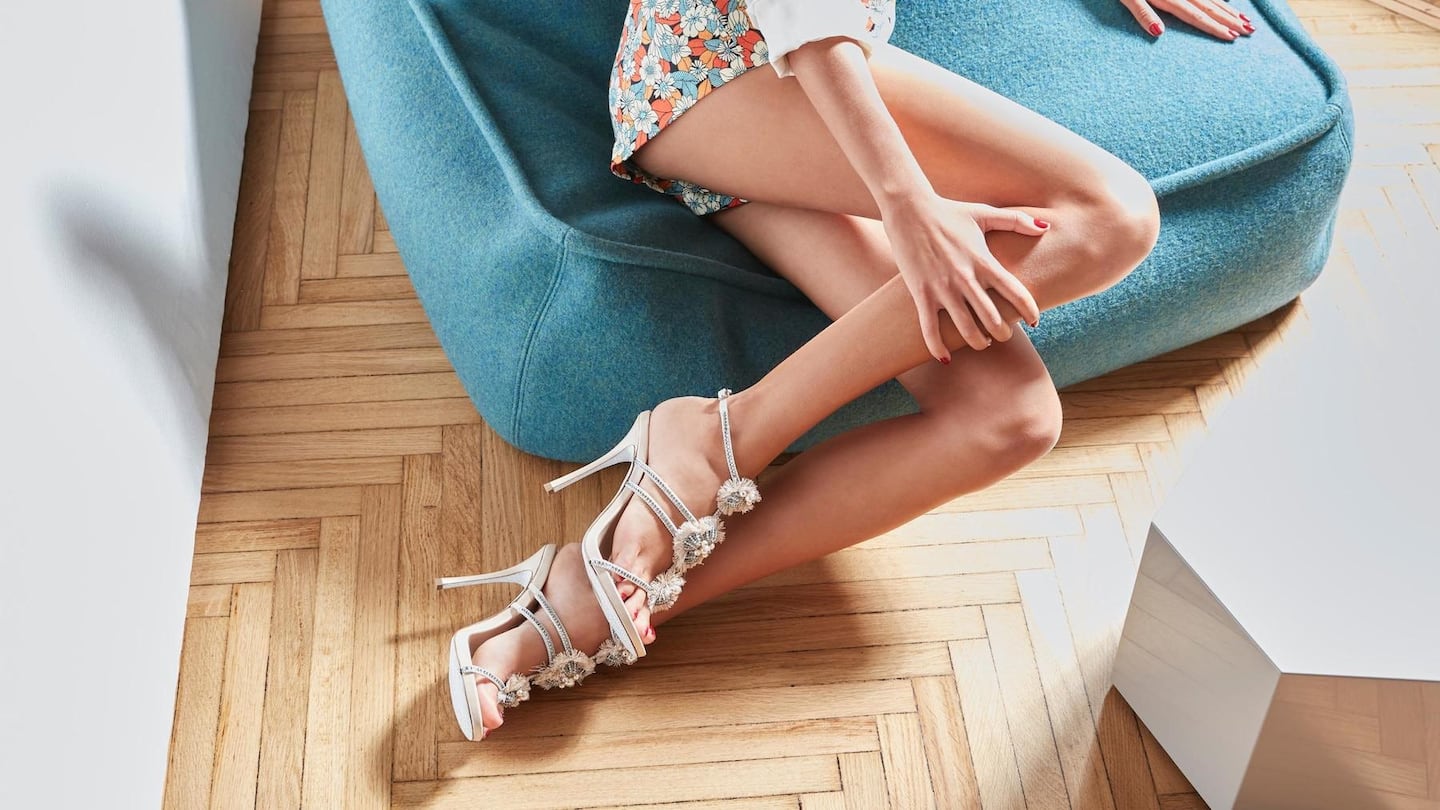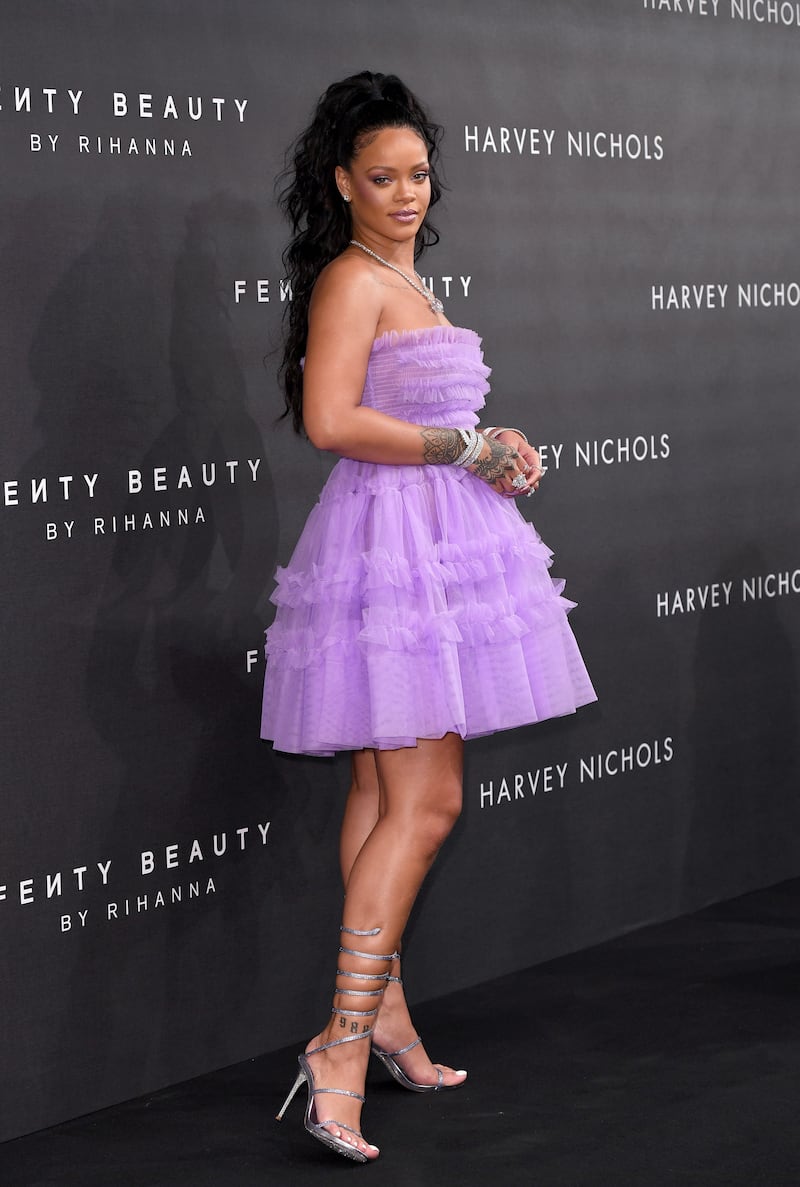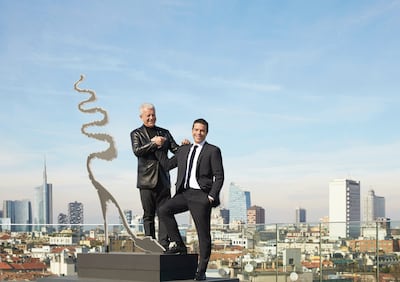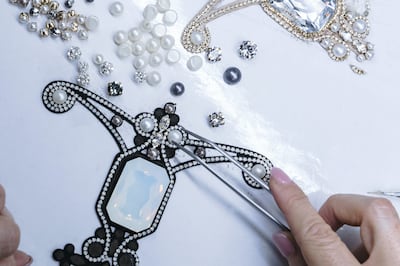
The Business of Fashion
Agenda-setting intelligence, analysis and advice for the global fashion community.

Agenda-setting intelligence, analysis and advice for the global fashion community.

MILAN, Italy — If the Hadid sisters are the current gold standard for celebrity influencer placements, high-end jewellery brand Bulgari could be considered quite fortunate to call Bella its accessories ambassador.
At Milan Fashion Week this past September, the younger Hadid co-hosted a high-wattage party in celebration of the house's handbag collaboration with accessories designer Nicholas Kirkwood. However, Bulgari was not the only brand to benefit from Hadid's appearance that evening. While she arrived at the event's step and repeat clad in Bulgari emeralds and diamonds, her shoes, revealed by the thigh-high slit on her floor-length black-velvet Ester Abner gown, were not Kirkwood, but instead a pair of pearl-strap pumps borrowed from the Italian footwear house René Caovilla.

Rihanna wearing René Caovilla shoes | Source: Courtesy
It may not be a name so well known outside of Italian fashion circles, but René Caovilla's sparkling statement sandals are currently popping up on the red carpet with a frequency atypical of a shoe label. (Heels, after all, are often hidden by floor-length gowns.) And yet, as of late, a multitude of celebrities, from Rihanna to Bella and Gigi to Robin Wright and Jane Fonda, are choosing Caovilla to complement their mullet hems.
ADVERTISEMENT
Edoardo Caovilla, creative director and chief operating officer of his family’s nearly 100-year-old company, insists he doesn’t “pay to play.” Regardless, René Caovilla's growing celebrity fanbase underscores the brand’s recent momentum, largely fuelled by the strategy the third-generation heir implemented after joining the family business in November 2009 following a stint in private equity. (The Caovilla family’s financial interests extend far beyond shoes into finance, media, real estate and energy.)
"I have the oldest shoe company in the world," says Caovilla, sitting in the rooftop garden of the company's Milan offices, which in January 2015 moved from Via Sant'Andrea to a more prestigious address on Corso Matteotti Giacomo, an upgrade meant to signal the label's new global status. "The challenge is to respect that DNA, but evolve it to reflect the contemporary market."
At the time of the now-41-year-old heir’s arrival, René Caovilla — named after Edoardo’s father, the company’s current president and longtime creative leader, but founded by his grandfather in the 1920s — was generating under $10 million a year in revenue. In 2017, sales are projected to reach between $50 million and $60 million.
So how did Caovilla get here? And how will the family, venerable players in the cultural and social fabric of Venice, Italy — just 20 minutes' drive away from company headquarters — capitalise on its newfound success?
For the uninitiated, the first thing to know about René Caovilla is that the shoes are expensive. Very expensive. For instance, a pair of d'Orsay kitten-heel pumps embellished with dozens of rows of teeny, rainbow-coloured Swarovski crystals will set a client back $1,650. A lace-covered mule flat, decorated with chunky tear-drop crystals, is $1,095. Caovilla says it's Swarovski's oldest account in Europe, and the label is heavily associated with bling. (Instead of lacquering its soles with a signature colour — it experimented with red decades before Christian Louboutin — many are now sprinkled with glitter dust.)
The house is also associated with an older consumer: the “mother of the bride,” as American department stores like to reference a certain set of ladies who might be inclined to invest two or three times a lifetime in ornately decorated, special-occasion footwear.
A [high] margin allows you to set up the right strategy. This is why we're growing and why some of our best-sellers are our most expensive shoes.
When the younger Caovilla entered the fray seven years ago, his goal was to make like Chanel and continue to serve the loyal client while introducing the Caovilla name to younger generations. Price point was non-negotiable. In fact, he actually increased the price of several styles by 30 to 35 percent. "A [high] margin allows you to set up the right strategy," Caovilla says. "It allows you to be clear. When customers understand how much quality there is on the back, they realise that the price is still low. This is why we're growing and why some of our bestsellers are our most expensive shoes."
René Caovilla products are made in Fiesso d'Artico, an industry town in Veneto, one of three regions in Italy regarded for its handcrafted women's luxury shoes (the others being Tuscany and Marche). While it now only manufactures its own label, the René Caovilla archives are peppered with others. At one point or another, the maison has built shoes for designers including Valentino Garavani, John Galliano at Christian Dior and Karl Lagerfeld at Chanel.
ADVERTISEMENT
Employees at the Fiesso d'Artico headquarters hail from more than 12 different countries spanning multiple generations, with one team member employed for more than 60 years. Each of the 38-or-so steps it takes to make a shoe is completed with precision, down to the final examination by someone whose job is to explicitly dust off each pair.

René and Edoardo Caovilla | Source: Courtesy
“You need to learn a new way to make the same thing,” Caovilla explains during a trip to the impeccably clean Fiesso d'Artico facilities, showing off the million-euro machinery that allows him to laser cut leather. Today, the average age of a factory employee is 40, down from 60 seven years ago. (The number of employees during that period has nearly tripled to 50 from almost 150.) “We needed to learn how to teach. The quality has always been what distinguishes René Caovilla from other brands.”
One way to conjure the value of the brand is to dramatise the historical significance of its headquarters, which is currently undergoing a major renovation, complete with the addition of a top-floor design studio lit by the sun and designed in the lavish Venetian style, all gold curly cues and pastel. (The company’s founder was born on the property, while its namesake was raised just a few hundred metres away.) The Caovilla family’s relationship to Venice, where it is heavily enmeshed in local society and cultural institutions like the Biennale, is another branding opportunity. “They could own Venice,” says Mario Ortelli, a luxury goods analyst at Sanford C. Bernstein. “There are not many brands that have made inroads there.”
However, before the youngest Caovilla even thought about sketching out a marketing plan, he tackled both distribution and merchandising. In 2010, 85 percent of René Caovilla product was distributed via wholesale partners. Today, 55 percent of the business is wholesale, while 45 percent is done through its 14 directly operated stores. By region, the business is split fairly evenly across the globe — a third in the Americas, a third in Europe and the Middle East, and a third in the Far East. He wants to open up more directly owned stores (and will do so in São Paulo, Brazil this November and Dubai this December), hitting 18 by February 2018 and reaching 60 within the next three years, working with Milan-based architecture and design firm m2atelier to bring modernity to the Venetian aesthetic.
However, key markets — including the US — are taking longer than first anticipated to tap. In New York City, for instance, the cost of a lease in a “prime” retail location — such as the Upper East Side, the brand’s most natural home — does not guarantee productivity. (The goal, right now, is to open New York by June 2018.) Caovilla’s willingness to wait and see signals a wider desire to achieve results first and glory later. “The new generation is not interested anymore in the moment of purchase,” Caovilla says, laying out store renderings on a coffee table. “A store used to be a place where you were producing turnover. Now it’s a place where you build relationships.”

Each René Caovilla shoe is completed with precision | Source: Courtesy
In terms of the product itself, Caovilla — who assumed the role of creative director from his father in 2011 — has worked to diversify (and modernise) the offering by adding more trend-driven pieces each season, from a white leather tennis shoe — Caovilla-ised with crystals — to a black combat boot, updated each season with new rhinestone embellishments. At the same time, its signature styles — like the jewel-encrusted sandal that snakes up the leg — have attained new relevance. Caovilla produces 200 to 250 different SKUs each season, with 10 to 12 carried-over styles, some of which have been in the collection for nearly 20 years, accounting for half of the business.
ADVERTISEMENT
For repeat customers, the proven quality of the shoe — which many in the market say is not currently rivalled — validates the price. “I think Caovilla is one of the most interesting and convincing high-end footwear brands in the market,” says Luca Solca, head of luxury goods at Exane BNP Paribas. “They stand head and shoulders above the rest in terms of quality, and have been able to build a clearly distinct brand position. Their idea of ‘scarpa gioiello’” — which translates to “jewelled shoes” — “is unique and fits very well with their Venetian heritage and DNA.”
But René Caovilla has also benefited from the rise in footwear as a status symbol. Shoes are the fastest growing category in the luxury market, reaching €18 billion ($21 billion) globally in 2017, up 10 percent from last year, according to an October 2017 report from Bain & Co. That jump is, at least in part, due to the continued increase in the average cost of a pair of designer shoes, the result of a combination of actual inflation, margin driving, consumer perception and market demand. In 2016, the number of high-net-worth individuals — those with assets that amount to at least $1 million — reached 16.5 million, a 7.5 percent increase from the previous year. This means that there are simply more people who can afford to pay a premium, and René Caovilla has capitalised on this.
However, Caovilla believes an even greater opportunity remains untapped. His goal is to hit $100 million in revenue in the next five years. At that point, he may entertain a public flotation. He says selling a part of the company to a luxury group or private equity firm — both of which generally prefer to take majority stakes — is not something he would consider at this time.
“I am full of friends in the private equity system. Once they came and asked if they could buy the company, now they come and ask what we suggest they should buy,” he says. “I have two daughters and a boy. Maybe they would love to work in the sector. If we are going to take some sort of visibility, it would be the listing.”
In order to reach that $100 million hurdle, Caovilla is now enacting the third stage of his plan: modernising the brand. Like any label with a strong heritage, he feels an obligation to preserve that legacy; given that the company is privately held, he has been able to move slowly. But now, with on-point product and an optimised distribution network, the heir to the Caovilla throne must communicate exactly what his brand means through a modern lens.
That includes refreshed advertising — shot in black-and-white by photographer Giampaolo Sgura and starring model Giulia Maenza, who was styled by Viviana Volpicella — and a new store concept, which will play to the brand's Venetian heritage with sea-blue walls and gold accents. Caovilla recognises retail as his greatest marketing platform.
Caovilla is very attractive acquisition target for the luxury groups.
Like many brands, the label has also focused on creating exclusive product for each location in the hopes of offering the consumer a compelling reason to walk through the door. Caovilla wants 40 percent of product in every store to be unique.
“I really believe in the concept of crossover. Nowadays, in the market, crossover describes what is happening in distribution — online, offline — and in products, like designer sneakers,” he says. “With the store, it’s that crossover again, between transaction and the relationship and service.”
He also sees designer collaborations in the brand's future, although he is less interested in the approach taken by rival Ferragamo — enlisting an outside designer, Paul Andrew, to oversee the house's visual identity — and is instead eager to mentor young designers. (In September 2017, René Caovilla announced a project with Italian Vogue to bring in young designers for three to six months of training .)

A shoe from the Spring 2018 collection | Source: Courtesy
“Many times, companies hire new designers and they become famous while the company does not do so well,” he says. “I’m really proud of being the third generation, and that I’ve been able to interpret the DNA in a contemporary way.”
The approach is not entirely unlike that of fellow Italian heritage brand Moncler, which has seen continued success by consistently delivering on a strategy of opening new stores in markets where wholesale has thrived, driving awareness through collaborations and frequently refreshing "hero" products that remain popular for decades. In 2016, Moncler posted sales exceeding $1 billion for the first time in its 65-year history, with net profits of nearly $230 million, just three years after it went public on the Milan stock market.
Of course, René Caovilla still has a long way to go before it gets anywhere close to matching the success of Moncler. For one, the company needs a more extensive brand revamp, likely including updates to its logo and packaging, which remain firmly traditional.
But with a strong brand equity and global awareness fairly limited, the potential is clear. While Caovilla insists he is not open to the advances of a conglomerate, it’s understandable why such groups would remain interested. “It’s a very attractive acquisition target for the luxury groups because it has heritage, iconic products, expertise in manufacturing a small quantity of products at the very high end, and it’s vertically integrated,” Ortelli says. “I call it a little gem — they have a very strong niche positioning.”
Regardless, potential abounds. There are opportunities not only to expand regionally, but also into new categories, including jewellery and handbags. However, Caovilla vows not to rush. After all, his family has been in the shoe business for nearly a century. “Time,” he says, “is the perfect judge.”
Disclosure: Lauren Sherman travelled to Italy as a guest of René Caovilla.
Related Articles:
[ Dissecting the Jimmy Choo Michael Kors DealOpens in new window ]
[ Beyond the “It” BagOpens in new window ]
[ 6 Lessons For Building a Winning Accessories BusinessOpens in new window ]
From analysis of the global fashion and beauty industries to career and personal advice, BoF’s founder and CEO, Imran Amed, will be answering your questions on Sunday, February 18, 2024 during London Fashion Week.
The State of Fashion 2024 breaks down the 10 themes that will define the industry in the year ahead.
Imran Amed reviews the most important fashion stories of the year and shares his predictions on what this means for the industry in 2024.
After three days of inspiring talks, guests closed out BoF’s gathering for big thinkers with a black tie gala followed by an intimate performance from Rita Ora — guest starring Billy Porter.